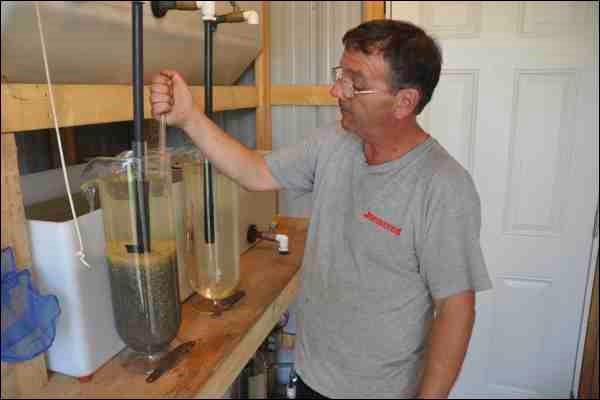By the time you read this thousands of new baby walleye fish may have entered the world.
About 300,000 walleye eggs have been incubating at a hatchery operated by the Lost Horse Creek Wildlife Federation at Lehman Creek in Cochin.
As of Tuesday night, May 28, the vast majority of the eggs had turned a dark colour - sure sign that they were ready to hatch soon.
Sure enough, during the visit of the Regional Optimist at 7 p.m. that night, it was noticed a couple of tiny fish were swimming around in the egg container, creating excitement among the volunteers there.
Those fish, no more than a couple of millimeters in size, were clearly seen in the egg container, a large jar that fills up with constantly flowing water from nearby Lehman Creek. The eggs require a constant flow of water so the eggs can move around.
The expectation is that even more fish should hatch within hours and swim from the egg jar into the main tank set up nearby.
Once they have all hatched, the fish will be poured into a transport container and transported up to Meeting Lake and released into the water. Volunteers are careful to not keep the fish too long at the hatchery, as they might begin to eat one other. That highlights the urgency of getting the fish into the wild as quickly as possible.
"The reality with walleye is you can't artificially feed them," said Brad Pattinson, president of the Lost Horse Creek Wildlife Federation. The walleye will need to move to a natural food source such as at the lake in order to survive, he said. Pattinson expected the fish to be released within 48 hours after the hatch.
This is the second year in a row the hatchery has been operating. Walleye eggs are picked up from Diefenbaker Lake, where the Ministry of Environment holds an annual spawn camp for the fish.
Last year the Lehman Creek hatchery obtained 280,000 of those eggs.
The majority of the eggs hatched and were released into Little Loon Lake, where they expect to grow into catchable fish.
This year, they had hoped to obtain a million eggs for the hatchery but Pattinson said that with the spring runoff the department simply was not able to produce that many eggs. They settled for 300,000.
A team of volunteers closely monitors the progress of the fish day and night.
They write up regular reports for the Ministry of Environment, and make sure the hatchery is operating properly by monitoring the temperatures and water levels.
One issue spotted quickly Tuesday night was of a minnow that had entered from the nearby creek, which plugged up the water in the hatchery. That is something known to happen every so often and which volunteers keep a close eye out for.
Pattinson said this year has been easier for the volunteers operating the hatchery, as they have a better idea on what they're doing after their experience last year.
One noticeable difference they are noticing is that temperatures have been somewhat warmer at the creek. As a result, the eggs have been incubating at a much faster rate.
"We're going to get equal or better than last year," said Pattinson. They are hoping over 80 per cent of their walleye eggs will hatch, which would be a good number for any hatchery.
Lost Horse Creek Wildlife Federation has been running the hatchery to promote conservation and enhancement of wildlife, as well as to serve an education function.
"It's a great education opportunity for people to come out and see how small a fish is when it's first out of the egg," said Pattinson.
He notes that when people do alterations to shorelines to get rid of weeds and put in a beach, it has a big impact on those small fish.
"To a fish that's the size of a piece of pepper, that's like a mountain range."
Visitors are encouraged to stop by and see the hatchery's activities for themselves. The hatchery is located right next to the Lehman Creek bridge on the main road in Cochin.
But Pattinson is telling people that if they want to check out the hatchery, they should come quickly because if they wait until next week, it's likely all the fish will be hatched by then.




